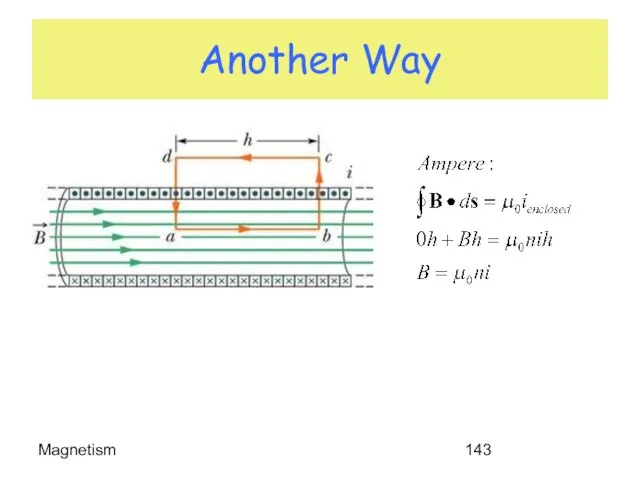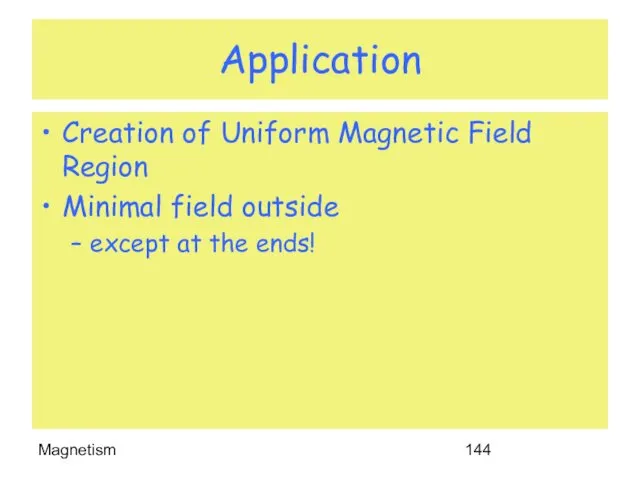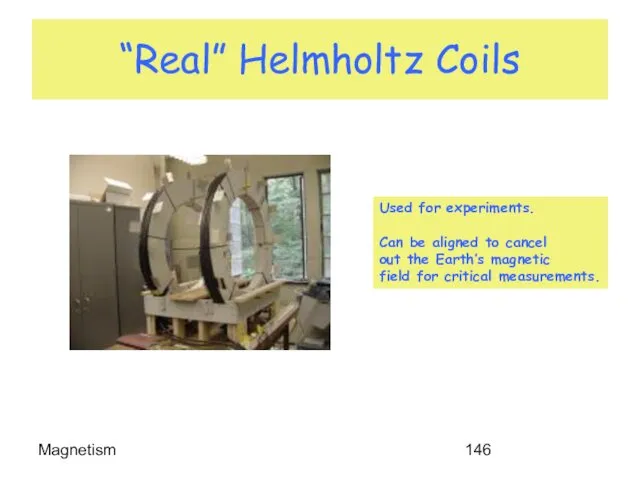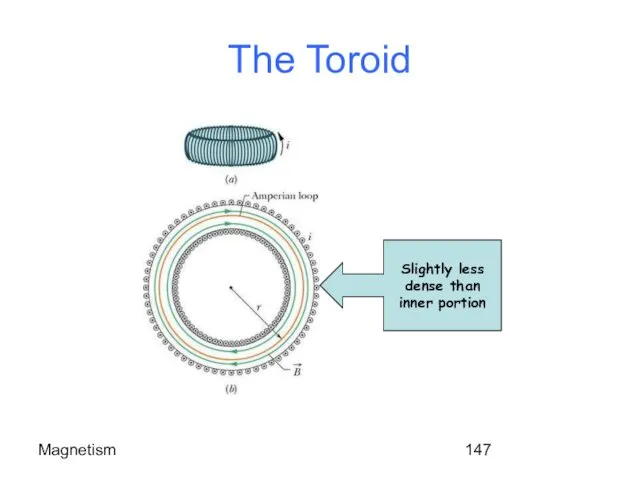Содержание
- 2. Magnetism A Whole New Topic
- 3. DEMO
- 4. Magnetism Lodestone (Mineral) Lodestones attracted iron filings. Lodestones seemed to attract each other. Used as a
- 5. Magnetism Magnetism Refrigerators are attracted to magnets!
- 6. Magnetism Applications Motors Navigation – Compass Magnetic Tapes Music, Data Television Beam deflection Coil Magnetic Resonance
- 7. Magnetism Magnets Like Poles Repel Opposite Poles Attract Magnetic Poles are only found in pairs. No
- 8. Magnetism Observations Bring a magnet to a charged electroscope and nothing happens. No forces. Bring a
- 9. Magnetism Magnets Cutting a bar magnet in half produces TWO bar magnets, each with N and
- 10. Magnetism Consider a Permanent Magnet
- 11. Magnetism Introduce Another Permanent Magnet The bar magnet (a magnetic dipole) wants to align with the
- 12. Magnetism The south pole of the small bar magnet is attracted towards the north pole of
- 13. Magnetism Field of a Permanent Magnet The field exerts a torque on the dipole The bar
- 14. Magnetism The Magnetic Field Similar to Electric Field … exists in space. Has Magnitude AND Direction.
- 15. Magnetism Convention For Magnetic Fields X Field INTO Paper Field OUT of Paper B
- 16. Magnetism Experiments with Magnets Show Current carrying wire produces a circular magnetic field around it. Force
- 17. Magnetism Current Carrying Wire Current into the page. Right hand Rule- Thumb in direction of the
- 18. Magnetism Current Carrying Wire B field is created at ALL POINTS in space surrounding the wire.
- 19. Magnetism Compass and B Field Observations North Pole of magnets tend to move toward the direction
- 20. Magnetism Planet Earth
- 21. Magnetism Inside it all. 8000 Miles
- 22. Magnetism On the surface it looks like this..
- 23. Magnetism Inside: Warmer than Floriduh
- 24. Magnetism Much Warmer than Floriduh
- 25. Magnetism Finally
- 26. Magnetism In Between The molten iron core exists in a magnetic field that had been created
- 27. Magnetism After molten lava emerges from a volcano, it solidifies to a rock. In most cases
- 28. Magnetism Ancient Navigation
- 29. Magnetism This planet is really screwed up! NORTH POLE SOUTH POLE
- 30. Magnetism Repeat Navigation DIRECTION N S If N direction is pointed to by the NORTH pole
- 31. Magnetism
- 32. Magnetism Rowland’s Experiment Rotating INSULATING Disk which is CHARGED + or – on exterior. xxx xxx
- 33. Magnetism A Look at the Physics There is NO force on a charge placed into a
- 34. Magnetism WHAT THE HECK IS THAT??? A WHAT PRODUCT? A CROSS PRODUCT – Like an angry
- 35. Magnetism The Lorentz Force This can be summarized as: v F B q m or: θ
- 36. Magnetism Note B is sort of the Force per unit (charge-velocity) Whatever that is!!
- 37. Magnetism Practice Which way is the Force??? B and v are parallel. Crossproduct is zero. So
- 38. Magnetism Units
- 39. Magnetism teslas are HUGE!
- 40. Magnetism The Magnetic Force is Different From the Electric Force. Whereas the electric force acts in
- 41. Magnetism So… A moving charge can create a magnetic field. A moving charge is acted upon
- 42. Magnetism Trajectory of Charged Particles in a Magnetic Field + + + + + + +
- 43. Magnetism Trajectory of Charged Particles in a Magnetic Field + + + + + + +
- 44. Magnetism Review of Rotational Motion
- 45. Magnetism YES ! You have to remember this stuff.
- 46. Magnetism + + + + + + + + + + + + + + +
- 47. Magnetism Cyclotron Frequency The time taken to complete one orbit is: V cancels !
- 48. Magnetism More Circular Type Motion in a Magnetic Field
- 49. Magnetism Mass Spectrometer
- 50. Magnetism
- 51. Magnetism Cyclotron Frequency The time taken to complete one orbit is: V cancels !
- 52. Magnetism An Example A beam of electrons whose kinetic energy is K emerges from a thin-foil
- 53. Magnetism Problem Continued
- 54. Some New Stuff Magnetism and Forces
- 55. Magnetism Let’s Look at the effect of crossed E and B Fields: x x x x
- 56. Magnetism What is the relation between the intensities of the electric and magnetic fields for the
- 57. Magnetism What does this mean?? This equation only contains the E and B fields in it.
- 58. Magnetism “Real” Mass Spectrometer Create ions from injected species. This will contain various masses, charges and
- 59. Magnetism Components of MS:
- 60. Magnetism Remember: THESE "E and B" GUYS ARE VECTORS! Let's Look at an example...
- 61. Magnetism VECTOR CALCULATIONS
- 62. Magnetism Problem: A Vector Example A proton of charge +e and mass m is projected into
- 63. Magnetism More
- 64. Magnetism New Topic Forces on Wires
- 65. Magnetism Wires A wire with a current contains moving charges. A magnetic field will apply a
- 66. Magnetism The Wire in More Detail B out of plane of the paper Assume all electrons
- 67. Magnetism Magnetic Levitation mg Where does B point???? Into the paper.
- 68. Magnetism MagLev
- 69. Magnetism Magnetic Repulsion
- 70. Magnetism Detail
- 71. Magnetism Moving Right Along ….
- 72. Magnetism Acceleration
- 73. Magnetism Don’t Buy A Ticket Quite Yet.. This is still experimental. Much development still required. Some
- 74. Magnetism Current Loop Loop will tend to rotate due to the torque the field applies to
- 75. Magnetism The Loop OBSERVATION Force on Side 2 is out of the paper and that on
- 76. Magnetism An Application The Galvanometer
- 77. Magnetism The other sides τ1=F1 (b/2)Sin(θ) =(B i a) x (b/2)Sin(θ) total torque on the loop
- 78. Magnetism Watcha Gonna Do Quiz Today Return to Magnetic Material Exams not yet returned. Sorry.
- 79. Magnetism Wires A wire with a current contains moving charges. A magnetic field will apply a
- 80. Magnetism The Wire in More Detail B out of plane of the paper Assume all electrons
- 81. Magnetism Current Loop Loop will tend to rotate due to the torque the field applies to
- 82. Magnetism Last Time τ1=F1 (b/2)Sin(θ) =(B i a) x (b/2)Sin(θ) total torque on the loop is:
- 83. Magnetism A Coil Normal to the coil RIGHT HAND RULE TO FIND NORMAL TO THE COIL:
- 84. Magnetism Dipole Moment Definition Define the magnetic dipole moment of the coil μ as: =NiA We
- 85. Magnetism Current Loop
- 86. Magnetism A length L of wire carries a current i. Show that if the wire is
- 87. Magnetism Problem continued…
- 88. Magnetism Energy
- 89. The Hall Effect
- 90. Magnetism What Does it Do? Allows the measurement of Magnetic Field if a material is known.
- 91. Magnetism Hall Geometry (+ Charge) Current is moving to the right. (vd) Magnetic field will force
- 92. Magnetism Negative Carriers Carrier is negative. Current still to the right. Force pushes negative charges to
- 93. Magnetism Hall Math Eventually, the field due to the Hall effect will allow the current to
- 94. Magnetic Fields Due to Currents Chapter 30
- 95. Magnetism Try to remember…
- 96. Magnetism For the Magnetic Field, current “elements” create the field. This, defines B! This is the
- 97. Magnetism Magnetic Field of a Straight Wire We intimated via magnets that the Magnetic field associated
- 98. Magnetism From the Past
- 99. Magnetism Right-hand rule: Grasp the element in your right hand with your extended thumb pointing in
- 100. Magnetism Let’s Calculate the FIELD Note: For ALL current elements ds X r is into the
- 101. Magnetism The Details
- 102. Magnetism Moving right along Verify this. 1/d
- 103. Magnetism A bit more complicated A finite wire
- 104. Magnetism P1
- 105. Magnetism More P1
- 106. Magnetism P2
- 107. Magnetism APPLICATION: Find the magnetic field B at point P in for i = 10 A
- 108. Magnetism Circular Arc of Wire
- 109. Magnetism More arc…
- 110. Magnetism Howya Do Dat?? No Field at C
- 111. Magnetism Force Between Two Current Carrying Straight Parallel Conductors Wire “a” creates a field at wire
- 112. Magnetism The Calculation
- 113. Magnetism Definition of the Ampere The force acting between currents in parallel wires is the basis
- 114. TRANSITION AMPERE
- 115. Welcome to Andre’ Marie Ampere’s Law Normally written as a “circulation” vector equation. We will look
- 116. Magnetism Remember GAUSS’S LAW?? Surface Integral
- 117. Magnetism Gauss’s Law Made calculations easier than integration over a charge distribution. Applied to situations of
- 118. Magnetism The next few slides have been lifted from Seb Oliver on the internet Whoever he
- 119. Magnetism Biot-Savart The “Coulombs Law of Magnetism”
- 120. Magnetism Invisible Summary Biot-Savart Law (Field produced by wires) Centre of a wire loop radius R
- 121. Magnetism Magnetic Field from a long wire I B r ds Using Biot-Savart Law Take a
- 122. Magnetism Sum B.ds around a circular path I B r ds Sum this around the whole
- 123. Magnetism Consider a different path Field goes as 1/r Path goes as r. Integral independent of
- 124. Magnetism SO, AMPERE’S LAW by SUPERPOSITION: We will do a LINE INTEGRATION Around a closed path
- 125. Magnetism Ampere’s Law USE THE RIGHT HAND RULE IN THESE CALCULATIONS
- 126. Magnetism The Right Hand Rule
- 127. Magnetism Another Right Hand Rule
- 128. Magnetism COMPARE Line Integral Surface Integral
- 129. Magnetism Simple Example
- 130. Magnetism Field Around a Long Straight Wire
- 131. Magnetism Field INSIDE a Wire Carrying UNIFORM Current
- 132. Magnetism The Calculation Graph ????
- 133. Magnetism
- 134. Magnetism Procedure Apply Ampere’s law only to highly symmetrical situations. Superposition works. Two wires can be
- 135. Magnetism The figure below shows a cross section of an infinite conducting sheet carrying a current
- 136. Magnetism FIRST PART Vertical Components Cancel
- 137. Magnetism Apply Ampere to Circuit
- 138. Magnetism The “Math” Bds=0 Distance not a factor!
- 139. Magnetism A Physical Solenoid
- 140. Magnetism Inside the Solenoid For an “INFINITE” (long) solenoid the previous problem and SUPERPOSITION suggests that
- 141. Magnetism More on Long Solenoid Field is ZERO! Field is ZERO Field looks UNIFORM
- 142. Magnetism The real thing….. Weak Field Stronger - Leakage Fairly Uniform field Finite Length
- 143. Magnetism Another Way
- 144. Magnetism Application Creation of Uniform Magnetic Field Region Minimal field outside except at the ends!
- 145. Magnetism Two Coils
- 146. Magnetism “Real” Helmholtz Coils Used for experiments. Can be aligned to cancel out the Earth’s magnetic
- 147. Magnetism The Toroid Slightly less dense than inner portion
- 149. Скачать презентацию


















































































































































 Аспекти розвитку ядерної енергетики. Сучасний стан радіаційної безпеки України
Аспекти розвитку ядерної енергетики. Сучасний стан радіаційної безпеки України Закон всемирного тяготения
Закон всемирного тяготения Атом, атомное ядро, атомная энергия
Атом, атомное ядро, атомная энергия Волновые механические передачи
Волновые механические передачи Равновесие тел
Равновесие тел Эксплуатация, диагностика и организация ремонта прокатного оборудования
Эксплуатация, диагностика и организация ремонта прокатного оборудования Тайна природы света
Тайна природы света Тиристор
Тиристор Законы последовательного соединения
Законы последовательного соединения Законы Кирхгофа
Законы Кирхгофа Механические характеристики металлов
Механические характеристики металлов Термодинамические циклы. Понятие о круговом процессе (цикле). Прямые и обратные циклы
Термодинамические циклы. Понятие о круговом процессе (цикле). Прямые и обратные циклы Физика и техника (7 класс)
Физика и техника (7 класс) Решение уравнения движения поезда методом МПС
Решение уравнения движения поезда методом МПС Обоснование работ по гидроразрыву пласта на каменной площади Красноленинского месторождения
Обоснование работ по гидроразрыву пласта на каменной площади Красноленинского месторождения Электрический ток в газах
Электрический ток в газах Уақыт тоқтатылуына тәуелсіз электрберіліс желісінің максималды қорғанысы
Уақыт тоқтатылуына тәуелсіз электрберіліс желісінің максималды қорғанысы Нанесение тонких плёнок. Практическое занятие №9
Нанесение тонких плёнок. Практическое занятие №9 Высота и тембр звука. Громкость звука
Высота и тембр звука. Громкость звука Физика в спорте
Физика в спорте Обобщающий урок в 8 классе Оптические явления
Обобщающий урок в 8 классе Оптические явления Технологический процесс технического обслуживания и ремонта системы смазки автомобиля ВАЗ -2110
Технологический процесс технического обслуживания и ремонта системы смазки автомобиля ВАЗ -2110 Расчет стержня детали на прочность при действии нагрузки от затяжки соединения, приложенной параллельно оси эксцентрично
Расчет стержня детали на прочность при действии нагрузки от затяжки соединения, приложенной параллельно оси эксцентрично Элементы квантовой физики. Тепловое излучение
Элементы квантовой физики. Тепловое излучение Величины, характеризующие колебательное движение
Величины, характеризующие колебательное движение Магнитное поле. Электромагнитная индукция
Магнитное поле. Электромагнитная индукция Конденсаторы. Классификация конденсаторов
Конденсаторы. Классификация конденсаторов Көтеріп-түсіру кешенін пайдалану барысында ілме блоктың құрылымын жетілдіру
Көтеріп-түсіру кешенін пайдалану барысында ілме блоктың құрылымын жетілдіру